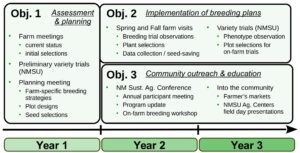Final report for OW20-353
Project Information
Practicing sustainable agriculture requires using less outside inputs and reducing environmental impact. In order to achieve this balance of productivity and resource frugality, a level of adaptiveness is demanded from both the crop and the farmer. For many vegetables grown in the U.S., generations of farmers saving their own seed resulted in the production of landrace varieties. These unique crops have evolved through selections made by the grower to promote tolerance to many stresses faced in a specific region. Currently, many of our efforts to publicly breed new vegetable varieties are focused on one location or institution, neglecting the diverse landscapes and climates that do not match these breeding sites. In addition, institutional breeding focuses on larger growers, and the cultural methods involved in large-scale production. These conditions are not the same for the small farmer, who grows for local markets and small food distributors. Many farmers in New Mexico are serving these small communities and are residing in different elevations and climatic conditions. We are proposing an initiation of the New Mexico Participatory Vegetable Breeding Program. The purpose of this project will be to educate and cooperate with small vegetable producers in New Mexico to create breeding and seed-saving operations on their own farms. The endeavor will help to increase and preserve diversity of crops grown in the state, as well as breed for hardiness in locally-adapted vegetables. This project aims to promote cultural heritage and local food economies through an innovative approach to plant breeding.
1. Development of breeding plans at each participant farm (Year 1)
Each farm/farmer focuses on specific needs for their respective crop. Thus, decisions need to be made with consideration of the land, cultural farming methods, and climate pertaining to each location. Farm visits will be conducted by the PI to discuss breeding goals and to take initial observations of the focus crops.
Outcome: Detailed plans for each farm indicating planting design, breeding workflow, data collection, and seed-saving strategies.
2. Implementation of breeding plans (Years 2 & 3)
This objective involves performing the annual process of planting, observing, selecting the best performers on the farm and in replicated field trials, seed-saving, and overall assessment of the growing season.
Outcome: Increased self-sufficiency of the farmer with on-farm breeding skills. Seed obtained from plant selections for continuation of breeding plan.
3. Education, outreach, and dissemination of results (Years 2 & 3)
A workshop for basic breeding techniques will be given for all farmer participants at the end of the first year, during the annual New Mexico Sustainable Agriculture Conference in December. Presentations will be made about current status and updates during a special session at this conference at the end of years 2 and 3. Distribution of brochures pertaining to the project will be done at public events such as the NM Sustainable Agriculture Conference, farmer’s markets and field days. Social media content describing the process and benefits of the program will be developed and released to the public. Field days given at an NMSU Agricultural Experiment Stations will showcase the variety trials being done for the project.
Outcome: An increased awareness across agricultural professionals and the general public about participatory vegetable breeding and the importance of locally-adapted vegetables.
Overview (Year 1)
This report outlines the research outcomes accomplished in the first year of the “Initiation of a New Mexico Participatory Vegetable Breeding Program.” The overall goal for this year focused on planning and assessment of farmer breeding goals, and initial plant selections. This work will progress the mission of increasing environmental adaptation and farmer autonomy with seed. During the spring and summer months of 2020, farm visits were carried out by PI’s Bradley Tonnessen and Charles Havlik. The visits pertained to planning of breeding projects in a 3-year model, as well as assessing the scale of work limited by labor, time, and space for each participant’s farmland. Plant breeding equipment was provided for each farmer as well, including cloth seed cages for genetic isolation of plant selections. Following these visits, farmers were in regular contact with the PI, and the proper collecting of seed was ensured. This year, the entire group, including participant farmers and PIs, met over Zoom for discussion about 2021 growing season plans. Plant selections will be grown for observation and in some cases, yield trials will be performed, for continuation of breeding efforts to develop locally adapted varieties of vegetables.
Overview (Year 2)
A major change of project PI occurred at the end of 2021. Dr. Bradley Tonnessen left New Mexico State University and his role as primary Pi of this grant. Dr. Charles Havlik assumed this responsibility
Issues due to COVID-19
Disruptions due to the COVID-19 pandemic reduced the number and duration of farm visits. Planned assistance in fieldwork that was to be provided by NMSU could not be accomplished. Multi-location variety trials were reduced to a single location in Las Cruces to minimize exposure risk. A notable setback involved one participant farmer, Travis McKenzie, who was unable to proceed with the campus farm at Van Buren Middle School location due to cutbacks in school programs.
The annual New Mexico Sustainable Agriculture Conference, funded by the WSARE professional development grant, was presented entirely online due to the pandemic. The on-line conference focused on a wide range of topics, including one session presented by the PI, Bradley Tonnessen, titled “Seed Saving and On-Farm Breeding.” This presentation highlighted the projects involved in the Participatory Vegetable Breeding Program.
Overview (Year 3)
The continued disruptions due to the COVID-19 pandemic reduced the number and duration of farm visits. Planned assistance in fieldwork that was to be provided by NMSU could not be accomplished. There were disruptions in crops reaching maturity, due to a number of reasons. For example, Seth Matlick of Viva Verde Farms had pest issues with rabbits and geese in his fields. Ramon Sias of Sias Growers direct seeded his chile in the spring and experienced a crop failure. He did use the materials issued to him to increase the seed of a different pepper cultivar. Anjel Ortiz of Zitro Farms had some personal issues to deal with in the spring. Miguel Santistevan and David Archuleta were able to continue refining their respective projects.
Project Outcomes by participant farmers
Seth Matlick, Vida Verde Farms, Albuquerque, NM
Seth Matlick is a mixed vegetable farmer, providing produce for restaurants and selling at local farmers markets. His breeding goal involves extending the growing season of lettuce further into the summer. His customers would enjoy buying lettuce heads later into summer, but many varieties of lettuce turn bitter and bolt due to the high heat. In order to work towards obtaining lettuce varieties that can resist bolting during heat stress, we began a variety trial at the Jose Fernandez Garden (JFG) at the NMSU campus in Las Cruces, NM.
The main goal of the lettuce variety trial was to identify lines with the highest heat tolerance. We selected eight different varieties claimed to be heat tolerant from multiple seed sources/companies (Table 1). To push the boundaries of heat tolerance, we planted a second trial of the same varieties to measure performance under higher heat in late spring/early summer. Each variety was grown in three replicated plots of 20 ft., organized in a randomized complete block design.
Lettuce yields were greater in the second trial. Lettuce size at maturity did not differ between successions. The improved performance of the second planting is most likely due to the correct timing between seeding and transplanting. The first trial had a severe delay in planting time due to weather conditions. Looking at both plantings, some varieties stood out for particular characteristics. Taste notes on each variety at harvest across both successions indicated that 7JFG20 (Anuenue) was the sweetest and least bitter of the eight varieties. In terms of heat tolerance, measured by latest time to bolting, the best performer was 3JFG20 (Mikola). Two other varieties, 1JFG20 (Parris Island Cos) and 6JFG20 (Sparx), were scored relatively high across all variables.
Seed was saved from the best non-patented lettuce cultivars. Due to high self-pollination in lettuce, short distance isolation is enough to keep seed pure. This fact allows us to save seed directly in the field. Seed saved, or purchased, for the top four varieties (Anuenue, Mikola, Parris Island Cos, and Sparx) were planted and transplanted at Vida Verde Farms (Spring 2021). Each variety was planted in three replicate plots, ten feet in length, with 25 heads per plot. The planned evaluation was assessment for yield, quality, and bolting time, with seed saving (unpatented cultivars) from the late bolting individuals for planting in future trials of 2022. The variety trial was repeated at the JFG in Las Cruces in spring 2021 as well to obtain enough data for submission to a peer reviewed journal.
The spring of 2022 experienced another setback for this project. This year there were pest issues with geese and rabbits.
Sparx (Figure 1).
Mikola (Figure 2).
Parris Island Cos (Figure 3).
Anuenue (Figure 4).
Figure 1. Sparx lettuce seedlings.
Figure 2. Mikola lettuce seedlings.
Figure 3. Parris Island Cos lettuce seedlings. .
Figure 4. Anuenue lettuce seedling.
Anjel Ortiz, Zitro Farms, Chimayó, NM
Anjel Ortiz is a farmer in the northern part of New Mexico, producing vegetables for local non-profits servicing the community and for sale at local markets. Anjel is striving to develop the traits of a famous landrace chile, ‘Chimayó.’ This type of chile pepper has a small pod relative to larger NM pod-types. It is adapted to a high elevation, dry climate and short growing season. Ultimately, he hopes to be a steward for this germplasm. Thus, learning genetic isolation and plant selection techniques are imperative for his goal. In 2020, Anjel planted about 500 plants each from five different seed sources provide by various families in the Chimayó region. Unlike many other chile growers, Anjel continues to sow his chile seed directly into the soil, using a method that dates back generations in Chimayó. In order to foster the traits that allow this variety to be hardy in the short growing season and cool weather, he continues to grow it in the cultural fashion in which it was developed. Through his experience and the knowledge of the community, he made selections of 14 plants that held phenotypic characteristics most like the classic ‘Chimayó‘ chile pepper. During our visit to his farm, we provided him with guidance on using insect netting to prevent pollinators from causing outcrossing with his selections. This involves removing all fruit and open flowers before covering to ensure future developed fruit is self-pollinated. In 2021, he planted 100 individuals from seed of each single plant selection. Observations and assessments of uniformity were planned for the season, with a second round of single plant selections. In 2021, his fields did not do well due to drought stress caused by acequia issues. The few rows he has remaining performed well, and may even be drought tolerant. In 2022, Anjel was not able to plant any of his ‘Chimayó‘ chile peppers due to personal reasons. Anjel does plan to continue his work with the ‘Chimayó‘ chile peppers in 2023. Figure 5. Chile plants growing at Zitro Farms in Chimayó, NM.
David Archuleta, Herbal & Chile Creations, Alcalde, NM
David Archuleta is a farmer, herbalist, and healer with a plot of land in northern New Mexico. He provides produce and herbal supplements at a local farmers market and for the surrounding community. He is currently working on developing high yielding, good tasting, appropriately shaped chile peppers resulting from a cross between ’Chimayó‘ and ’Espanola Improved.’ The variety ’Espanola Improved’ comes from a 1984 NMSU breeding program release. This chile exhibits early maturity, producing long, thin pods with broad shoulders. The cross results in a small size pepper, with somewhat wrinkled skin, and a characteristic thickness and taste. The segregation among his population is high, so our goal is to make single plant selections, using insect-excluding mesh bags. The long-term goal is to bring uniformity and consistently high yields to the breeding line.
Using seed selected in 2020, David Archuleta planted 12 rows of chile selected for uniformity and consistently high yields (Figure 7). He planted a row from seed of his best single plant selections from last year. Each one shows some segregation but all look healthy. In 2021, twelve single plant selections were covered with insect-excluding bags to obtain self-pollinated seed (Figure 6). This resulting seed will be planted in plots of >100 plants per selection in spring 2022.
David made single plant selections again in 2022 to refine the phenotypes, and used large seed cages for larger groups of plants that looked uniform for his traits of interest.
Figure 6. David Archuleta’s amongst single plant selections that were covered with insect-excluding bags to obtain self-pollinated seed.
Figure 7. Selecting for uniformity and high yields.
Miguel Santistevan, Sol Feliz Farm, Taos, NM
Miguel Santistevan is a farmer and teacher who practices seed saving and permaculture on his small farm in northern NM. His seed saving project involves the ’Melon Mexicano.’ This type of melon has remained a staple in his family for generations. He obtained the seed recently, and after growing it out, realized that it had outcrossed with other melons such as honeydew. The original seed for this project came from the true-to-type melon. This is because its characteristic fruit shape, aesthetic, and flesh have shown dramatic levels of segregation in the population. Thus, our project focuses on rescuing the phenotype of the ’Melon Mexicano‘ from this existing germplasm. The goal of this project was to stabilize the genetics or otherwise obtain phenotypic consistency within the population over generations. The original seed for this project came from the true-to-type melon on the right, center (Figure 9). Subsequent experience with this seed stock indicates phenotypes that vary in the rind texture and flesh color of the fruits. It is thought that these variations originated from cross-pollination with cantaloupe and honeydew in the past, or prior to 2007, but likely much earlier. In 2019, true-to-type melons still exhibit phenotypes from hybridization with cantaloupe and honeydew in the color of the flesh (Figure 9). In 2020, irrigation was disrupted and only a few plants survived to maturity. Of those plants, a few had the phenotype of interest. Those seeds were collected and saved for planting in late spring 2021. Each fruit was brought to maturity to maximize the selection population in 2021. The plants resembling the expected phenotype were self-pollinated and crossed with similar individuals. Only this seed will be saved for planting in 2022.
In 2021, the second year of the project, plants exhibited normal growth with sufficient acequia irrigation supplemented with drip lines (Figure 8). Two true-to-type melons were harvested. The best was noted for its true-to type character and exceptional flavor. In 2022, Miguel continued the cultivation of seed stock developed over the last two years of the project. The stated goals of the seed stock included, inbreeding or selective cross-pollination to further identify individuals with true-to-type characteristics.
Figure 8. The original seed for this project came from the true-to-type melon on the right, center.
Figure 9. True-to-type melons still exhibit phenotypes from hybridization with cantaloupe and honeydew in the color of the flesh.
Ramon Sias, Sias Growers, Corrales, NM
Ramon Sias is a mixed vegetable grower in central New Mexico, near Albuquerque. He grows produce for farmers markets and bulk selling within the community. He has developed a green chile variety known as ’Corrales Native.’ This fruit has a longer and thinner phenotype compared to traditional NM green chile such as ’Big Jim.’ The taste and look of ’Corrales Native’ green chile has attracted buyers due to its special quality characteristics. Recently, the germplasm has become contaminated with commercial variety genetics due to accidental cross-pollination. This project aims to preserve the phenotype of ’Corrales Native’ amidst neighboring farmers growing commercial varieties. During the farm visit, we made selections and bagged 14 different plants with desired fruit characteristics, healthy and vigorous growth, and high yield.
Later in the season, an outbreak of Fusarium Wilt occurred in the field. Due to this, many plants did not mature fully, and seed may have been scarce from some of the selections. In 2021, all the seeds from the surviving plants were planted (100 plants for each selection) for further plant selection and seed saving to preserve the ’Corrales Native‘ phenotype.
In 2022, Ramon direct seeded his ’Corrales Native’ chile peppers into the field. Unfortunately, none of the crop germinated. Ramon did use the materials to save seed for another variety of chile pepper from Italy called ‘Calabrian’ (Figures 10 and 11).
Figure 10. ’Calabrian’ chile pepper plants selected for desired phenotypic traits.
Figure 11. A single ’Calabrian’ chile pepper plant selected for desired phenotypic traits.
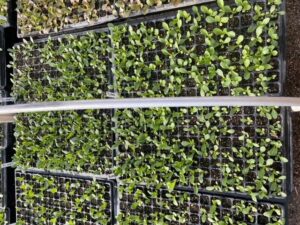
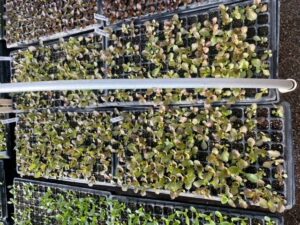
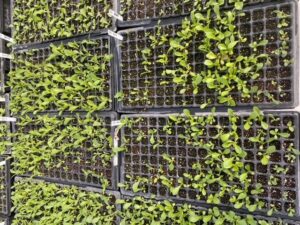
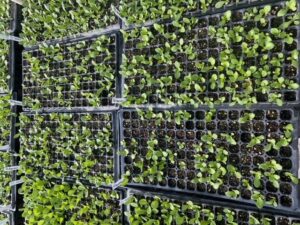
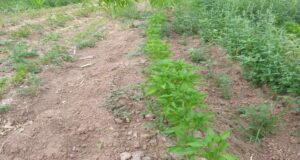
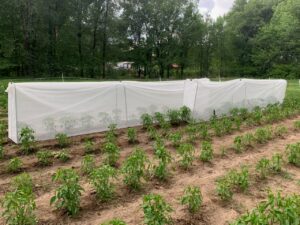
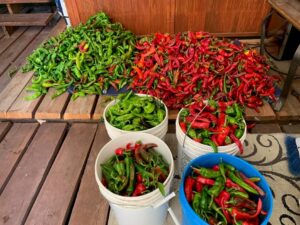
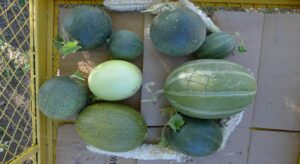
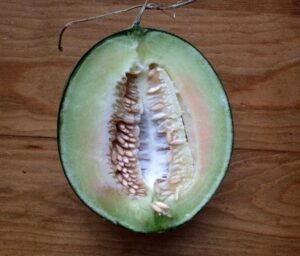


Figure 1: Timeline of objectives
Year 1
The first year of the project is a planning and assessment phase (Fig. 1). The first growing season will involve farm visits from the PI to assess the current status of each farmers’ operations and vegetables in question. There will be two visits to each location, one at the start of the season, and one at the time of harvest. Two participants will need initial variety testing (Vida Verde Farm, Van Buren Middle School). These variety trials will be started in the spring of 2020 at NMSU agricultural experiment stations for observation and selection. At the end of year 1, all participants will attend the NM Sustainable Agriculture Conference for a planning meeting and educational workshop.
Years 2 & 3
These two years will be focused on implementation of breeding plans, continuation of farm visits, and outreach activities (Fig. 1). Participants market booths will advertise the program, and NMSU will promote the program at the Las Cruces Farmers Market. At the NMSU Sustainable Agriculture conference in December of both years, participants, the PI, and Co-PIs will present on current status, and well as host a session on breeding for the public.
Cooperators
- - Producer
- - Producer
- - Producer (Educator)
- - Producer
- - Producer
- - Producer
Research
Experiment Locations
The experimental sites used for this study include each participant’s farm and other growing sites affiliated with NMSU, representing different growing regions present across New Mexico.
NMSU Agricultural Science Center at Los Lunas. 1036 Miller Road, Los Lunas, NM 87031. Centered in the Middle Rio Grande region. Representing climatic conditions of farms in/near cities of Albuquerque and Corrales.
NMSU Sustainable Agriculture Science Center at Alcalde. 371 County Road 40, Alcalde, NM 87511. A research site for conditions in north-central NM.
NMSU Jose Fernandez Memorial Garden (JFMG). NMSU Main Campus, Las Cruces, NM 88003. Started in 2019 by Co-PI, Dr. Stephanie Walker, under the Jose Fernandez endowed chair award. This field is a designated vegetable trial garden to identify new varieties and species capable of being grown in the southern NM region.
On-Farm Breeding Method Toolbox
There are multiple conventional breeding strategies for improving or adapting vegetable varieties for specific regions. The utilization of these different methods at each participant’s farm will be dependent on their respective breeding needs. The methods that are reasonable for this project are defined below:
1. Variety Trials
This is a test of multiple publicly/commercially available crop varieties presumed to display a desired trait such as heat tolerance. They are planted simultaneously and evaluated based on their performance. This is especially helpful when a trait is needed, but the grower has no initial variety preference.
2. Single Plant Selection
In a population of a particular variety that varies in phenotype (segregating), a single plant can be selected that stands out with the desired traits. The flowers from this plant can be genetically isolated and seed then saved for planting the subsequent generation.
3. Genetic Isolation / Variety Maintenance
The risk of outcrossing with undesirable wild relatives or different varieties of the same species is an important issue for farmers trying to preserve genetically unique varieties. In this project, it pertains to landrace chile and melons. There are various tools to manage this problem and keep cross-pollination from occuring, such as the use of cloth mesh cages, isolation by distance, or other physical barriers. When trying to keep a variety genetically stable with steady allele frequencies (variety maintenance), certain numbers of the crop must be planted for seed (Colley et al 2010). During variety maintenance, individual plants that are phenotypic outliers can be removed from the population before seed harvest.
Development of Breeding Plans (Obj. 1) and Implementation of these plans (Obj. 2)
Each farm will present new and different challenges with their respective breeding needs. The details of each participant farm are given in Table 1.
- Obj. 1:
Assessments at each farm will be performed by the PI through farm visits, starting in the spring of 2020, with a second visit at the time of harvest for each focus crop. For all of the participating farms, this will involve discussions on farming methods, planting times, expected and observed plant phenotypes, and a plan for the following year.
For farms where variety trials will need to be implemented (Vida Verde Farm and Van Buren Middle School), the crops will be pro-actively planted in spring of 2020 at NMSU JFMG prior to the expected award date of this proposed project. Varieties of lettuce, melons, and landrace chile will be planted in a replicated, randomized complete block design to assess heat tolerance, yield, watering rate, and fertility requirements. Best performers will be tested at the respective farms in year 2, as well as at the NMSU Los Lunas station, which represents the climate of both farms.
Two participants, Zitro Farms and Sol Feliz Farm, are in need of genetic preservation of their landrace chile and melon, “Chimayo,” and “Melon Mexicano,” respectively. Due to the fact that outcrossing with conventional varieties has already occurred, the first step in achieving a “phenotype rescue” will involve single plant selections for the historical landrace phenotype. These selections can be made during year 1 of the project.
The remaining participant farms, Sias Growers, and Herbal & Chile Creations, are pursuing a consistent, improved phenotype for a crop that has been grown for many generations on their land. During the first year of the project, single plant selections will be made. The genetically isolated seed will be planted the following year at the participant’s farm and/or NMSU Alcalde.
- Obj. 2:
During the next two years of the project, the breeding goals will be continued. Genetically isolated seed from single plants will be expanded to replicated small plot trials. The target phenotype will be assessed for consistency across replicates. During this stage, separate plots independent of observational experiments will be isolated for bulk seed production. If the line of seed shows a consistent positive phenotype in the experimental plots, bulk seed will be used for subsequent field trials.
Project Outcomes
Overview (Year 1)
This report outlines the research outcomes accomplished in the first year of the “Initiation of a New Mexico Participatory Vegetable Breeding Program.” The overall goal for this year focused on planning and assessment of farmer breeding goals, and initial plant selections. This work will progress the mission of increasing environmental adaptation and farmer autonomy with seed. During the spring and summer months of 2020, farm visits were carried out by PI’s Bradley Tonnessen and Charles Havlik. The visits pertained to planning of breeding projects in a 3-year model, as well as assessing the scale of work limited by labor, time, and space for each participant’s farmland. Plant breeding equipment was provided for each farmer as well, including cloth seed cages for genetic isolation of plant selections. Following these visits, farmers were in regular contact with the PI, and the proper collecting of seed was ensured. This year, the entire group, including participant farmers and PIs, met over Zoom for discussion about 2021 growing season plans. Plant selections will be grown for observation and in some cases, yield trials will be performed, for continuation of breeding efforts to develop locally-adapted varieties of vegetables.
Issues due to COVID-19
Disruptions due to the COVID-19 pandemic reduced the number and duration of farm visits. The farm visits focused on assistance in field work that was planned to be provided by NMSU could not be accomplished. Multi-location variety trials were reduced to a single location in Las Cruces to minimize exposure risk. A notable setback involved one participant farmer, Travis McKenzie, who was unable to proceed with the project due to cutbacks in school programs, including the campus farm at Van Buren Middle School. The annual New Mexico Sustainable Agriculture Conference, funded by the WSARE professional development grant, was cancelled due to the pandemic. Instead, a weekly webinar series was held in the months of October and November. The subjects focused on a wide range of topics, including one workshop held by the PI, Bradley Tonnessen, titled “Seed Saving and On-Farm Breeding.” This presentation highlighted the projects involved in the Participatory Vegetable Breeding Program.
Project Outcomes by participant farmers
Seth Matlick, Vida Verde Farms, Albuquerque, NM
Seth Matlick, owner/ operator of Viva Verde farms, is a mixed vegetable farmer, providing produce for restaurants and selling at local farmers markets. His breeding goal involves extending the growing season of lettuce further into the summer.
The main goal of the lettuce variety trial was to identify lines with the highest heat tolerance. Taste notes on each variety at harvest across both successions indicated that 7JFG20 (Anuenue) was the sweetest and least bitter of the eight varieties. In terms of heat tolerance, measured by latest time to bolting, the best performer was 3JFG20 (Mikola). Two other varieties, 1JFG20 (Parris Island Cos) and 6JFG20 (Sparx), were scored relatively high across all variables. Seed was saved from the best non-patented lettuce cultivars. Due to high self-pollination in lettuce, short distance isolation is enough to keep seed pure.
A very intense hailstorm at the Viva Verde farm during the spring of 2021 was a setback for this project. Viva Verde farm was not able to obtain any records of how the four varieties performed during that season. In 2022, Seth had significant issues in all of his fields with a number of pests. The most problematic on the lettuce trials were damage from geese and coyotes.
Anjel Ortiz, Zitro Farms, Chimayó, NM
Anjel Ortiz is a farmer in the northern part of New Mexico, producing vegetables for local non-profits servicing the community and for sale at local markets. Anjel is striving to develop the traits of a famous landrace chile, ‘Chimayó.’ This type of chile pepper has a small pod relative to larger NM pod-types. It is adapted to a high elevation, dry climate and short growing season. Ultimately, he hopes to be a steward for this germplasm. Thus, learning genetic isolation and plant selection techniques are imperative for his goal. In 2020, Anjel planted about 500 plants each from five different seed sources provide by various families in the Chimayó region. Unlike many other chile growers, Anjel continues to sow his chile seed directly into the soil, using a method that dates back generations in Chimayó. In order to foster the traits that allow this variety to be hardy in the short growing season and cool weather, he continues to grow it in the cultural fashion in which it was developed. Observations and assessments of uniformity were planned for the season, with a second round of single plant selections. In 2021, his fields did not do well due to drought stress caused by acequia issues. The few rows he has remaining performed well, and may even be drought tolerant. In 2022, Anjel was not able to plant another crop of ‘Chimayó’ chile due to some personal issues.
David Archuleta, Herbal & Chile Creations, Alcalde, NM
David Archuleta is a farmer, herbalist, and healer with a plot of land in northern New Mexico. He provides produce and herbal supplements at a local farmers market and for the surrounding community. He is currently working on developing high yielding, good tasting, appropriately shaped chile peppers resulting from a cross between ’Chimayó‘ and ’Espanola Improved.’ The long-term goal is to bring uniformity and consistently high yields to the breeding line.
Using seed selected in 2020, David Archuleta planted 12 rows of chile selected for uniformity and consistently high yields. He planted a row from seed of his best single plant selections from last year. Each one shows some segregation, but all look healthy. In 2021, twelve single plant selections were covered with insect-excluding bags to obtain self-pollinated seed. This resulting seed was planted in plots of >100 plants per selection in spring 2022.
David has continued his single plant selections again in 2023 to refine the phenotypes. He plans to continue this work beyond the scope of the grant project. He would potentially like to use large seed cages for larger groups of plants if they look uniform for the traits of interest.
Miguel Santistevan, Sol Feliz Farm, Taos, NM
Miguel Santistevan is a farmer and teacher who practices seed saving and permaculture on his small farm in northern NM. His seed saving project involves the ’Melon Mexicano.’ This type of melon has remained a staple in his family for generations. He obtained the seed recently, and after growing it out, realized that it had outcrossed with other melons such as honeydew. The original seed for this project came from the true-to-type melon. This is because its characteristic fruit shape, aesthetic, and flesh have shown dramatic levels of segregation in the population. Thus, our project focuses on rescuing the phenotype of the ’Melon Mexicano‘ from this existing germplasm. The goal of this project was to stabilize the genetics or otherwise obtain phenotypic consistency within the population over generations. Each fruit was brought to maturity to maximize the selection population in 2021. The plants resembling the expected phenotype were self-pollinated and crossed with similar individuals. Only this seed will be saved for planting in 2022.
In 2021, the second year of the project, plants exhibited normal growth with sufficient acequia irrigation supplemented with drip lines. Two true-to-type melons were harvested. The best was noted for its true-to type character and exceptional flavor. Future goals include plans to continue the cultivation of seed stock developed over the last two years of the project. Goals for the seed stock include, inbreeding or selective cross-pollination to further identify individuals with true-to-type characteristics.
Miguel Has continued selecting this melon in the summers of 2022 and 2023.
Ramon Sias, Sias Growers, Corrales, NM
Ramon Sias is a mixed vegetable grower in central New Mexico, near Albuquerque. He grows produce for farmers markets and bulk selling within the community. He has developed a green chile variety known as ’Corrales Native.’ During the farm visit, we made selections and bagged 14 different plants with desired fruit characteristics, healthy and vigorous growth, and high yield.
Later in the season, an outbreak of Fusarium Wilt occurred in the field. Due to this, many plants did not mature fully, and seed may have been scarce from some of the selections. In 2021, all the seeds from the surviving plants were planted (100 plants for each selection) for further plant selection and seed saving to preserve the ’Corrales Native‘ phenotype.
In 2022, Ramon had direct seeded his chile field, this was the first time he did not use transplants. Ultimately, there was no germination, resulting in a crop failure. He did use the supplies to save seed from a completely different pepper cultivar.
in 2023, Ramon did not farm at all.
Research Outcomes
Education and Outreach
Participation Summary:
Education and Outreach Activities
Consultations (7)
For this project, the initial goal in year 1 specified farm visits from the PI and Co-PI, Bradley Tonnessen and Charles Havlik, respectively. During the spring and summer of 2020, Dr. Tonnessen and Mr. Havlik provided consultations to each of our five participant farmers on methods of plant selection, seed saving strategies for each targeted vegetable, and recommendations for experimental methods. Participant farmers, explaining their breeding projects to neighboring farmers, gave another two consultations. They gave advice on seed saving and maintaining a genetically stable population for their neighbors’ chile.
Curricula, factsheets, or educational tools (1)
During this spring semester of 2021 at New Mexico State University, Dr. Stephanie Walker and Dr. Bradley Tonnessen taught a Special Topics course (AGRO 449) on vegetable breeding. This class highlighted the various breeding and seed saving projects conducted by the vegetable extension program at NMSU. The students learned about chile breeding techniques and basic genetics concepts for a complete understanding of the breeding process. They also learn how to grow various vegetables with intent on saving seed. Content of the course includes anecdotes and data shared from activities pertaining to the NM Participatory Vegetable Breeding Program.
Journal Articles (1)
Joukhadar, I., Tonnessen, B. W., Coon, D., Walker, S. 2023. Performance of Heat Tolerant Lettuce (Lactuca sativa) Cultivars in Southern New Mexico in 2020-21. HortTechnology. Accepted, not published.
On-Farm Demonstrations (0)
Due to COVID-19 restrictions, farm visits planned for members of the public were cancelled.
Online Trainings (1)
Tonnessen, B. W. 2021. Seed saving for local adaptation: Lessons from the New Mexico participatory plant-breeding program. Norwegian Seed Savers (KVANN), March 2021 [Virtual Workshop](Seed Saving for Local Adaptation: Lessons from the New Mexico Participatory Plant Breeding Program | Facebook)
This online training was presented to members of the Norwegian Seed Savers (KVANN) (https://kvann.no/). The workshop was three hours, and the content explained how to establish a participatory breeding program, and the results and experiences made from the first year of this program in New Mexico.
Published Press Articles, Newsletters (2)
Tonnessen, B. W. 2021. Organic chile farming in New Mexico. Chile Pepper Institute Newsletter. February 2021. (Link could not be found)
This publication explained the various ways that farmers successfully grow chile using organic methods in New Mexico. The newsletter article was informed by interviews with various farmers, including the farmers on this particular project.
Walker, S., Tonnessen, B. W., Joukhadar, I., Garvin, L. 2020. Smart Vegetable Seed Saving for Home Gardeners and Small Farmers. NMSU Cooperative Extension Service. In press. (Vegetable Seed Saving for Home Gardeners and Small-scale Farmers | New Mexico State University - BE BOLD. Shape the Future. (nmsu.edu)
This publication focused on seed saving methods, genetic isolation techniques, and population management for New Mexicans interested in seed saving. The article contained many of the techniques currently being used by farmers on this project.
Tours, Workshop Field Days (0)
There was a 2023 NM Sustainable Agriculture Workshop is Ultra-Local Production: Micro, Small and Urban farms. This workshop featured a NM WSARE Grant Recipients Panel Discussion (Cristóbal Valencia, Brian Schutte, Eva Stricker, Marcy Ward, Charles Havlik). The date was March 30, 2023 at the Santa Fe County Extension office.
There was also a NM Agriculture Sustainability Workshop held on May 17 - 18, 8 a.m. to 3 p.m., Larry P. Abraham Agri-Nature Center, 4920 Rio Grande Blvd NW. The free two-day workshop included presentations by experts complemented by field demonstrations. The theme of the workshop was Ultra-Local Production: Micro, Small and Urban farms.
In 2022, we presented the results from this project at the WSARE Sustainable Agriculture Conference or Online Workshop Series. There was a workshop entitled, New Mexico Agriculture Sustainability in Las Cruces, NM. Set for June 26 through the 28th. This was a field day to highlight the vegetable variety trials occurring at the Jose Fernandez Garden. Participant farmers were asked to give a presentation at these events as well. A peer-reviewed publication was published on the lettuce variety trials being conducted for Vida Verde Farms (listed above).
These events were conducted as of the date of this submission. The events generated a lot of productive discissions and potential future collaborations.
A seed saving workshop concluded on September 12th, for September 2023 at the NMSU Los Lunas Agricultural Science Center. As of the date of this submission, there have been numerous local heirloom and landrace vegetables planted specifically for this event at the NMSU Agricultural Science Center in Los Lunas. The plantings include, beans, chile, cucumber, melons squash and tomatoes.


Dr. Stephanie Walker and myself showcased the project at the Santa Fe Farmer’s Market on September 9th, 2023.
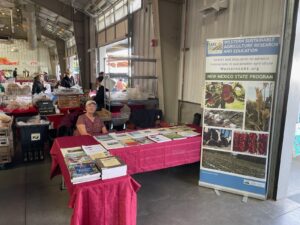
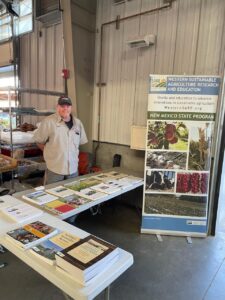
Webinars, Talks, Presentations (4)
Tonnessen, B. W. 2021. Organic methods of chile production in New Mexico. New Mexico Chile Conference, February 2021, Las Cruces, NM [Oral Presentation]
The New Mexico Chile Conference is an annual event held in Las Cruces, NM. This oral presentation was given about the successful organic farming of chile in NM. Many of the farmer testimonials in this presentation were from participant farmers on this project. Two participants attended this conference in person, Anjel Ortiz of Zitro Farms and Ramon Sias of Sias Growers.
Tonnessen, B. W. 2020. Seed saving and on-farm breeding. New Mexico Sustainable Agriculture Online Workshop Series. October 2020, virtual [Oral Presentation]
The WSARE-funded Sustainable Agriculture Workshop Series was held online in 2020 due to COVID-19 restrictions. Of the multiple workshop presentations, this presentation focused on on-farm breeding techniques showcased from farmers that are participants on this granted project.
Tonnessen, B. W. 2020. Epigenetics for the seed saver. Seed School for Farmers, Rocky Mountain Seed Alliance. October 2020, virtual. [Oral Presentation]
This presentation was given to the members of the non-profit, Rocky Mountain Seed Alliance. The presentation gave an overview of the genetic aspects of seed saving and gave examples of landrace chile and lettuce experiments done by participant farmers on this project.
Havlik, C. & Tonnessen, B. W. 2020. Participatory breeding project for NM. Los Lunas Ag Science Center Virtual Chile Field Day. September 2020, Los Lunas, NM.
This presentation was during a virtual field day. PI and Co-PI Bradley Tonnessen and Charles Havlik gave an overview of the latest updates on this project.
Other (1)
“SARE Farmer Fly-In”
The PIs of this project were contacted by coordinators of SARE in Washington, D.C. regarding an annual event known as the “Farmer Fly-in.” Bradley Tonnessen and participant farmer, David Archuleta, agreed to join in this event. During the week of March 22nd, Dr. Tonnessen and Mr. Archuleta had two virtual meetings. The first met with directors of SARE and NIFA, and the second was with staffers from the office of Senator Martin Heinrich. During these meetings, the personal experiences and community benefits of this project and SARE in New Mexico were presented. The goal of these meetings were to give real-life examples of what this federal funding is achieving. The meetings were a great success and new relationships have been cultivated.
Upcoming activities
As the PIs presented on seed saving, the findings from this project were presented, with WSARE acknowledged.
Report the results or findings you achieved up to date according to each project’s educational and outreach objectives. If possible, include quantitative and/or qualitative findings such as effective ways to communicate results, engage producers, reach underserved communities, teach students, etc.
For this project, the initial goal in year 1 specified farm visits from the PI and Co-PI, Bradley Tonnessen and Charles Havlik provided consultations to each of our five participant farmers on methods of plant selection, seed saving strategies for each targeted vegetable, and recommendations for experimental methods. Participant farmers, explaining their breeding projects to neighboring farmers, gave another two consultations. They gave advice on seed saving and maintaining a genetically stable population for respective crops.
Curricula, factsheets, or educational tools (1)
During this spring semester of 2021 at New Mexico State University, Dr. Stephanie Walker and Dr. Bradley Tonnessen taught a Special Topics course (AGRO 449) on vegetable breeding. This class highlighted the various breeding and seed saving projects conducted by the vegetable extension program at NMSU. The students learned about chile breeding techniques and basic genetics concepts for a complete understanding of the breeding process. They also learn how to grow various vegetables with intent on saving seed. Content of the course includes anecdotes and data shared from activities pertaining to the NM Participatory Vegetable Breeding Program.
Journal Articles (1)
Joukhadar, I., Tonnessen, B. W., Coon, D., Walker, S. 2023. Performance of Heat Tolerant Lettuce (Lactuca sativa) Cultivars in Southern New Mexico in 2020-21. HortTechnology. Accepted, not published.
On-Farm Demonstrations (0)
Due to COVID-19 restrictions, farm visits planned for members of the public were cancelled.
Online Trainings (1)
Tonnessen, B. W. 2021. Seed saving for local adaptation: Lessons from the New Mexico participatory plant-breeding program. Norwegian Seed Savers (KVANN), March 2021 [Virtual Workshop](Seed Saving for Local Adaptation: Lessons from the New Mexico Participatory Plant Breeding Program | Facebook)
This online training was presented to members of the Norwegian Seed Savers (KVANN) (https://kvann.no/). The workshop was three hours, and the content explained how to establish a participatory breeding program, and the results and experiences made from the first year of this program in New Mexico.
Published Press Articles, Newsletters (2)
Tonnessen, B. W. 2021. Organic chile farming in New Mexico. Chile Pepper Institute Newsletter. February 2021. (Link could not be found)
This publication explained the various ways that farmers successfully grow chile using organic methods in New Mexico. The newsletter article was informed by interviews with various farmers, including the farmers on this particular project.
Walker, S., Tonnessen, B. W., Joukhadar, I., Garvin, L. 2020. Smart Vegetable Seed Saving for Home Gardeners and Small Farmers. NMSU Cooperative Extension Service. In press. (Vegetable Seed Saving for Home Gardeners and Small-scale Farmers | New Mexico State University - BE BOLD. Shape the Future. (nmsu.edu)
This publication focused on seed saving methods, genetic isolation techniques, and population management for New Mexicans interested in seed saving. The article contained many of the techniques currently being used by farmers on this project.
Tours, Workshop Field Days (0)
There was a 2023 NM Sustainable Agriculture Workshop is Ultra-Local Production: Micro, Small and Urban farms. This workshop featured a NM WSARE Grant Recipients Panel Discussion (Cristóbal Valencia, Brian Schutte, Eva Stricker, Marcy Ward, Charles Havlik). The date was March 30, 2023 at the Santa Fe County Extension office.
There is also a NM Agriculture Sustainability Workshop held on May 17 - 18, 8 a.m. to 3 p.m., Larry P. Abraham Agri-Nature Center, 4920 Rio Grande Blvd NW. The free two-day workshop includes presentations by experts complemented by field demonstrations. Theme is Ultra-Local Production: Micro, Small and Urban farms.
In 2022, we intend to continue presentation of the results from this project at the WSARE Sustainable Agriculture Conference or Online Workshop Series (depending on COVID-19 restrictions). There will be a workshop entitled, New Mexico Agriculture Sustainability in Las Cruces, NM. Set for June 26 through the 28th. There will be a field day to highlight the vegetable variety trials occurring at the Jose Fernandez Garden. Participant farmers will be asked to give a presentation at these events as well. A peer-reviewed publication is planned for the lettuce variety trials being conducted for Vida Verde Farms (listed above).
These events were conducted as of the date of this submission. The events generated a lot of productive discissions and potential future collaborations.
A seed saving workshop was planned and concluded on September 12th, for September 2023 at the NMSU Los Lunas Agricultural Science Center. As of the date of this submission, there have been numerous local heirloom and landrace vegetables planted specifically for this event at the NMSU Agricultural Science Center in Los Lunas. The plantings include, beans, chile, cucumber, melons squash and tomatoes.
The investigators showcased the project at the Santa Fe Farmer’s Market on September 9th, 2023.
Webinars, Talks, Presentations (4)
Tonnessen, B. W. 2021. Organic methods of chile production in New Mexico. New Mexico Chile Conference, February 2021, Las Cruces, NM [Oral Presentation]
The New Mexico Chile Conference is an annual event held in Las Cruces, NM. This oral presentation was given about the successful organic farming of chile in NM. Many of the farmer testimonials in this presentation were from participant farmers on this project. Two participants attended this conference in person, Anjel Ortiz of Zitro Farms and Ramon Sias of Sias Growers.
Tonnessen, B. W. 2020. Seed saving and on-farm breeding. New Mexico Sustainable Agriculture Online Workshop Series. October 2020, virtual [Oral Presentation]
The WSARE-funded Sustainable Agriculture Workshop Series was held online in 2020 due to COVID-19 restrictions. Of the multiple workshop presentations, this presentation focused on on-farm breeding techniques showcased from farmers that are participants on this granted project.
Tonnessen, B. W. 2020. Epigenetics for the seed saver. Seed School for Farmers, Rocky Mountain Seed Alliance. October 2020, virtual. [Oral Presentation]
This presentation was given to the members of the non-profit, Rocky Mountain Seed Alliance. The presentation gave an overview of the genetic aspects of seed saving and gave examples of landrace chile and lettuce experiments done by participant farmers on this project.
Havlik, C. & Tonnessen, B. W. 2020. Participatory breeding project for NM. Los Lunas Ag Science Center Virtual Chile Field Day. September 2020, Los Lunas, NM.
This presentation was during a virtual field day. PI and Co-PI Bradley Tonnessen and Charles Havlik gave an overview of the latest updates on this project.
Seth Matlick, Vida Verde Farms, Albuquerque, NM
Seth Matlick is a mixed vegetable farmer, providing produce for restaurants and selling at local farmers markets. His breeding goal involves extending the growing season of lettuce further into the summer. The main goal of the lettuce variety trial was to identify lines with the highest heat tolerance. We selected eight different varieties claimed to be heat tolerant from multiple seed sources/companies (Table 1). To push the boundaries of heat tolerance, we planted a second trial of the same varieties to measure performance under higher heat in late spring/early summer. Each variety was grown in three replicated plots of 20 ft., organized in a randomized complete block design.
Lettuce yields were greater in the second trial. Lettuce size at maturity did not differ between successions. The improved performance of the second planting is most likely due to the correct timing between seeding and transplanting. The first trial had a severe delay in planting time due to weather conditions. Looking at both plantings, some varieties stood out for particular characteristics. Taste notes on each variety at harvest across both successions indicated that 7JFG20 (Anuenue) was the sweetest and least bitter of the eight varieties. In terms of heat tolerance, measured by latest time to bolting, the best performer was 3JFG20 (Mikola). Two other varieties, 1JFG20 (Parris Island Cos) and 6JFG20 (Sparx), were scored relatively high across all variables.
Seed was saved from the best non-patented lettuce cultivars. Due to high self-pollination in lettuce, short distance isolation is enough to keep seed pure. This fact allows us to save seed directly in the field. Seed saved, or purchased, for the top four varieties (Anuenue, Mikola, Parris Island Cos, and Sparx) were planted and transplanted at Vida Verde Farms (Spring 2021). Each variety was planted in three replicate plots, ten feet in length, with 25 heads per plot. The planned evaluation was assessment for yield, quality, and bolting time, with seed saving (unpatented cultivars) from the late bolting individuals for planting in future trials of 2022. The variety trial was repeated at the JFG in Las Cruces in spring 2021 as well to obtain enough data for submission to a peer reviewed journal.
Anjel Ortiz, Zitro Farms, Chimayó, NM
Anjel Ortiz is a farmer in the northern part of New Mexico, producing vegetables for local non-profits servicing the community and for sale at local markets. Anjel is striving to develop the traits of a famous landrace chile, ‘Chimayó.’ This type of chile pepper has a small pod relative to larger NM pod-types. It is adapted to a high elevation, dry climate and short growing season. Ultimately, he hopes to be a steward for this germplasm. Thus, learning genetic isolation and plant selection techniques are imperative for his goal. In 2020, Anjel planted about 500 plants each from five different seed sources provide by various families in the Chimayó region. In order to foster the traits that allow this variety to be hardy in the short growing season and cool weather, he continues to grow it in the cultural fashion in which it was developed. Through his experience and the knowledge of the community, he made selections of 14 plants that held phenotypic characteristics most like the classic ‘Chimayó‘ chile pepper. During our visit to his farm, we provided him with guidance on using insect netting to prevent pollinators from causing outcrossing with his selections. This involves removing all fruit and open flowers before covering to ensure future developed fruit is self-pollinated. In 2021, he planted 100 individuals from seed of each single plant selection. Observations and assessments of uniformity were planned for the season, with a second round of single plant selections. In 2021, his fields did not do well due to drought stress caused by acequia issues. The few rows he has remaining performed well, and may even be drought tolerant. In 2022, Anjel was not able to plant any of his ‘Chimayó‘ chile peppers due to personal reasons. Anjel does plan to continue his work with the ‘Chimayó‘ chile peppers in 2023.
David Archuleta, Herbal & Chile Creations, Alcalde, NM
David Archuleta is a farmer, herbalist, and healer with a plot of land in northern New Mexico. He provides produce and herbal supplements at a local farmers market and for the surrounding community. He is currently working on developing high yielding, good tasting, appropriately shaped chile peppers resulting from a cross between ’Chimayó‘ and ’Espanola Improved.’ The variety ’Espanola Improved’ comes from a 1984 NMSU breeding program release. This chile exhibits early maturity, producing long, thin pods with broad shoulders. The cross results in a small size pepper, with somewhat wrinkled skin, and a characteristic thickness and taste. The segregation among his population is high, so our goal is to make single plant selections, using insect-excluding mesh bags. The long-term goal is to bring uniformity and consistently high yields to the breeding line.
Using seed selected in 2020, David Archuleta planted 12 rows of chile selected for uniformity and consistently high yields (Figure 7). He planted a row from seed of his best single plant selections from last year. Each one shows some segregation but all look healthy. In 2021, twelve single plant selections were covered with insect-excluding bags to obtain self-pollinated seed (Figure 6). This resulting seed will be planted in plots of >100 plants per selection in spring 2022.
David made single plant selections again in 2022 to refine the phenotypes, and used large seed cages for larger groups of plants that looked uniform for his traits of interest.
Miguel Santistevan, Sol Feliz Farm, Taos, NM
Miguel Santistevan is a farmer and teacher who practices seed saving and permaculture on his small farm in northern NM. His seed saving project involves the ’Melon Mexicano.’ This type of melon has remained a staple in his family for generations. He obtained the seed recently, and after growing it out, realized that it had outcrossed with other melons such as honeydew and cantaloupe. The original seed for this project came from the true-to-type melon. This is because its characteristic fruit shape, aesthetic, and flesh have shown dramatic levels of segregation in the population. Thus, our project focuses on rescuing the phenotype of the ’Melon Mexicano‘ from this existing germplasm. The goal of this project was to stabilize the genetics or otherwise obtain phenotypic consistency within the population over generations. Each fruit was brought to maturity to maximize the selection population in 2021. The plants resembling the expected phenotype were self-pollinated and crossed with similar individuals. Only this seed will be saved for planting in 2022.
In 2021, the second year of the project, plants exhibited normal growth with sufficient acequia irrigation supplemented with drip lines (Figure 8). Two true-to-type melons were harvested. The best was noted for its true-to type character and exceptional flavor. In 2022, Miguel continued the cultivation of seed stock developed over the last two years of the project. The stated goals of the seed stock included, inbreeding or selective cross-pollination to further identify individuals with true-to-type characteristics.
Ramon Sias, Sias Growers, Corrales, NM
Ramon Sias is a mixed vegetable grower in central New Mexico, near Albuquerque. He grows produce for farmers markets and bulk selling within the community. He has developed a green chile variety known as ’Corrales Native.’ This fruit has a longer and thinner phenotype compared to traditional NM green chile such as ’Big Jim.’ The taste and look of ’Corrales Native’ green chile has attracted buyers due to its special quality characteristics. Recently, the germplasm has become contaminated with commercial variety genetics due to accidental cross-pollination. This project aims to preserve the phenotype of ’Corrales Native’ amidst neighboring farmers growing commercial varieties. During the farm visit, we made selections and bagged 14 different plants with desired fruit characteristics, healthy and vigorous growth, and high yield.
Later in the season, an outbreak of Fusarium Wilt occurred in the field. Due to this, many plants did not mature fully, and seed may have been scarce from some of the selections. In 2021, all the seeds from the surviving plants were planted (100 plants for each selection) for further plant selection and seed saving to preserve the ’Corrales Native‘ phenotype.
In 2022, Ramon direct seeded his ’Corrales Native’ chile peppers into the field. Unfortunately, none of the crop germinated. Ramon did use the materials to save seed for another variety of chile pepper from Italy called ‘Calabrian’
Education and Outreach Outcomes
Due to the early stage of the project (Year 1), this section will be left blank until completion of the proposed activities.
